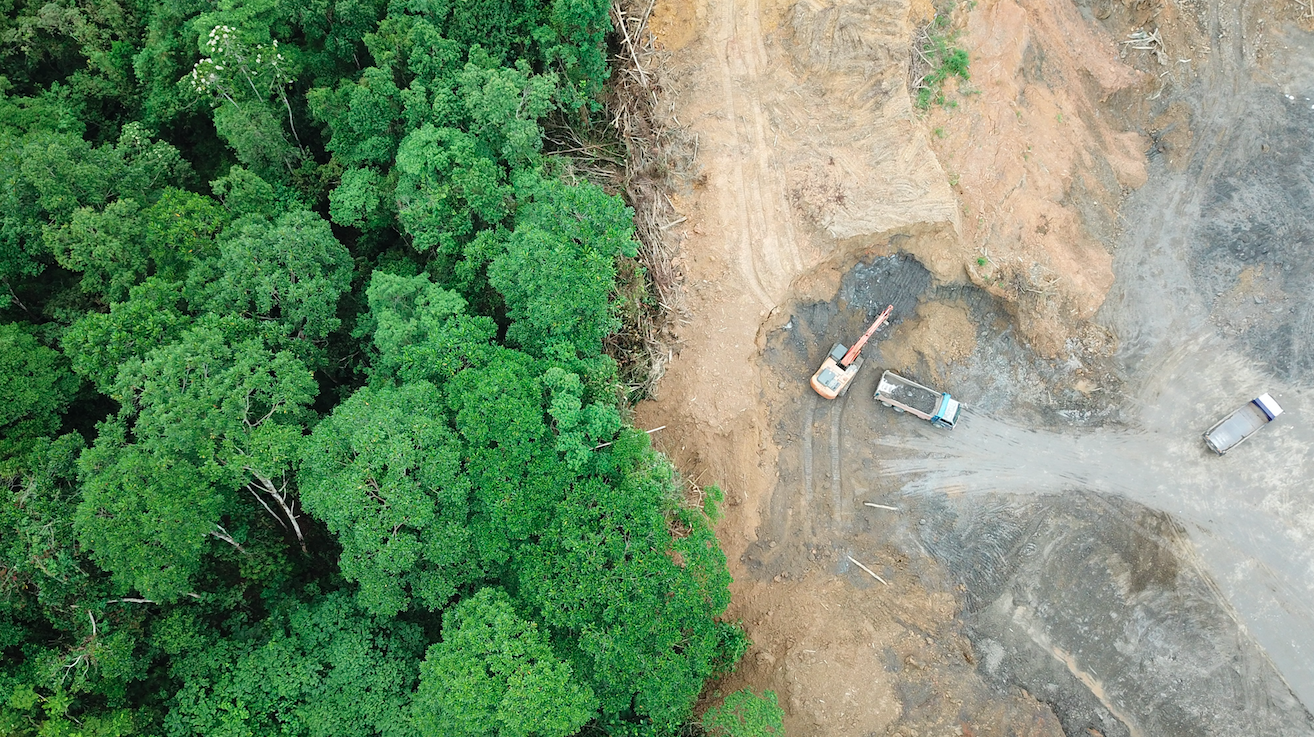
Decades ago, rampant logging looked set to decimate forests in Malaysia. That is no longer the case but a less familiar force is driving forest change – one over which state governments have full control. This is Part 2 of the Forest Files series.
The 1970s were the golden age of logging in Peninsular Malaysia, veteran loggers told Macaranga. Then the federal government came up with the National Forestry Policy in 1978 and the National Forestry Act in 1984 to promote sustainable forestry in the country.
As a result, most forests in Peninsular Malaysia were gradually reclassified as permanent reserve forests (PRFs).
PRFs serve primarily as renewable sources of timber and are managed by each state's forestry department according to sustainable practices.
These practices include logging only selected trees and resting forest blocs up to 30 years after logging.
I wanted to see evidence of such practices. So, in June, I followed a logger to his logging site in a PRF in Johor.
En route, we drove through a bloc of PRF on a muddy road not much wider than a jeep.
My logger guide explained that this bloc was last logged in the early 1970s – before sustainable logging was compulsory in PRFs – by operators who used light machinery, took only the most valuable timber and left much of the site untouched.
The undergrowth was dense and the trees tall. Although I did not see giant trees of the sort found in virgin forest, I did not see any signs of logging damage either.
It works
What I saw suggests that sustainable forestry practices in Peninsular Malaysia can conserve forests, at least as far as the evidence of a few decades has shown.
It is too early to tell if sustainable forestry can conserve forests for perpetuity, as the National Forestry Policy envisions.
Most forest researchers and conservationists to whom Macaranga spoke agreed that rigorous sustainable logging methods in Malaysia can allow for logged forests to regenerate well.
Furthermore, there are third-party certification schemes that use market forces to promote sustainable forestry.
Throughout Malaysia, including Sabah and Sarawak, the Malaysian Timber Certification Council (MTCC) acts as the national governing body that oversees the Malaysian Timber Certification Scheme (MTCS).
The MTCC was established in 1998 and is a company limited by guarantee and independent of government.
Sustainability certificates
MTCC promotes the certification of forestry and timber products in Malaysia that meet international standards of sustainable practices.
In 2009, the MTCS was endorsed by the Programme for the Endorsement of Forest Certification (PEFC), the largest forest certification programme worldwide.
Because the certificates grant access to premium markets like the European Union (EU), the scheme encourages sustainable forestry in Malaysia, conservationists and foresters told Macaranga.
For the last 4 years (2016 – 2019), timber exports to the EU fetched higher sales per volume than other regions. (Figure 1).
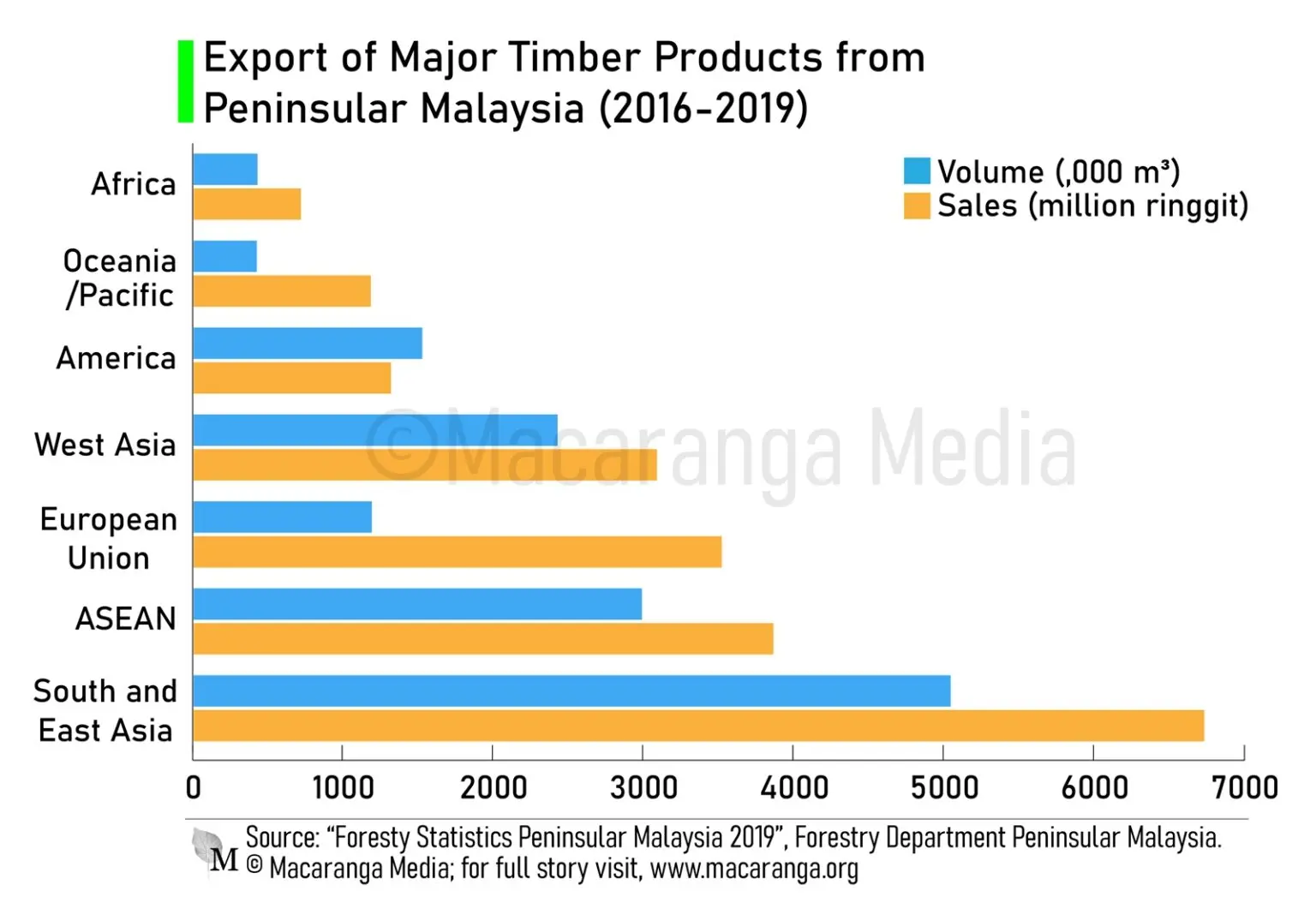
It appears then that within PRFs, a combination of legal and market forces can facilitate sustainable logging and conserve the forests.
What then of forests outside of PRFs?
There, the National Forestry Act does not apply. That means that outside of PRFs, forests can be legally clear-cut.
As of 2019, PRFs make up about 85.5% (4.9 million hectares) of forests in Peninsular Malaysia; protected parks (e.g., Taman Negara) and wildlife reserves make up another 10.3% (589,569 hectares).
The remaining 4.2% (240,968 hectares) of forest sits on state land for development purposes. (Figure 2)
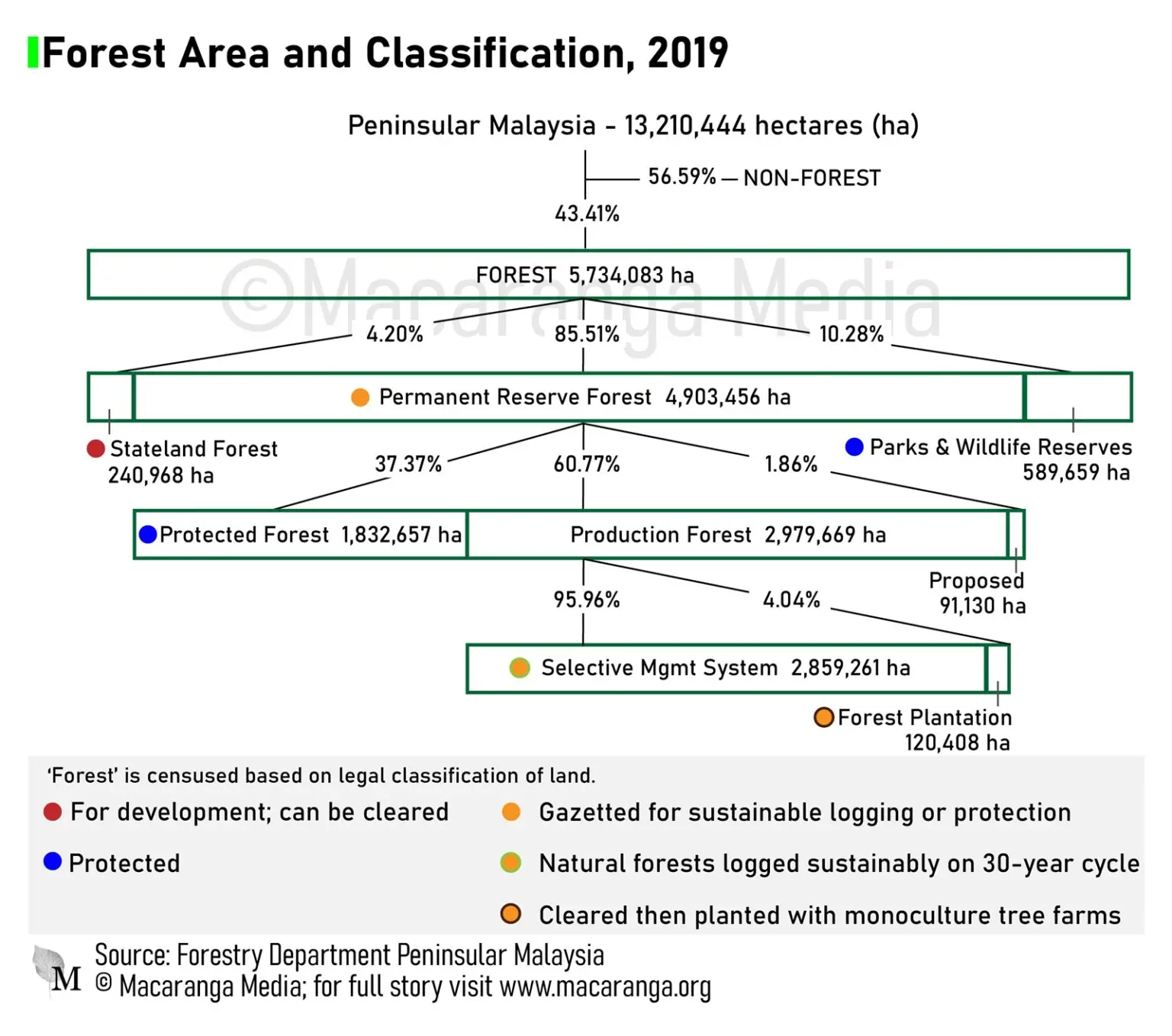
This might indicate that most forests in Peninsular Malaysia are safe from unsustainable logging and clear-cutting.
But this is far from the reality because the PRF is a classification that can be stripped from or given to any piece of land at any time.
And only one party can do that – state governments.
Authority over land
In Malaysia, the Federal Constitution (PDF link) ) grants state governments sole authority over land.
The exceptions are the federal territories of Kuala Lumpur, Putrajaya and Labuan, where land authority is vested in the federal government.
What’s more, excising an area from a PRF in Peninsular Malaysia involves just one simple step: the state government publishes the excision in a gazette, an official government notice.
Adding PRFs
Conversely, state governments can add areas to PRFs by the same process. In the peninsula, these procedures are outlined in the National Forestry Act.
State governments often excise or expand PRFs (Table 1).
PRF land could be excised and reclassified as state land or private land, neither of whose management needs to apply sustainable forestry principles. The opposite happens in PRF expansions.
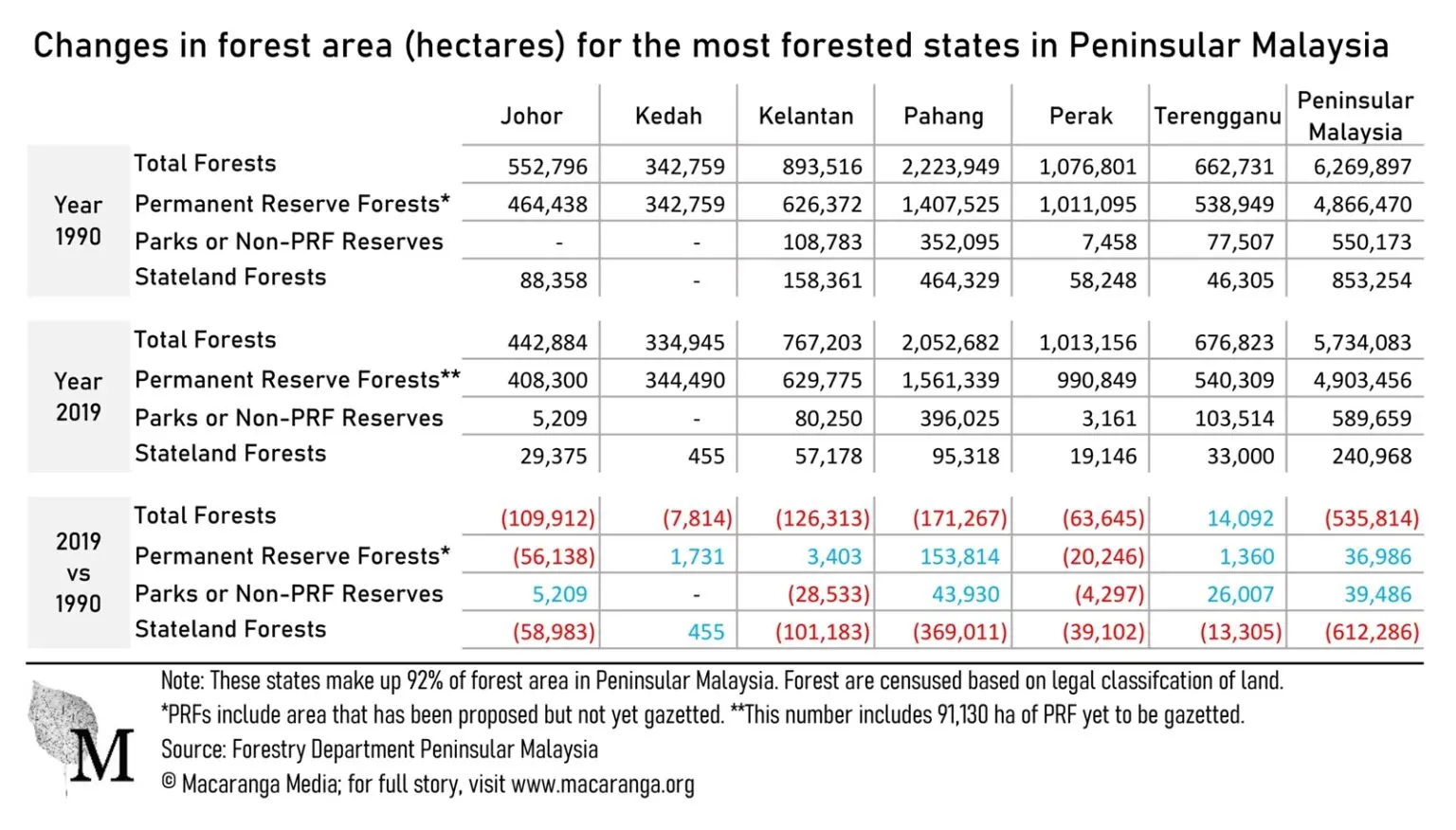
To illustrate the possible consequences – environmental, economic, and social – of excising forests from PRFs, Macaranga examined the result of two recent PRF excisions in Johor.
Case Study: A 17,532 hectare excision in Johor
The Jemaluang PRF and the Tenggaroh PRF, gazetted in 1923 and 1951 respectively, sat along the northeastern coast of Johor.
In 2015, both PRFs amounting to 17,532 hectares, were excised by the Johor government.
The land was transferred into private ownership with agricultural status, according to environmental impact assessment (EIA) documents sighted by Macaranga.
A 5% limit
At the time, all of Johor’s PRFs had the MTCS forest management certification.
The certification allows only a 5% limit on forest conversion. The excised Jemaluang and Tenggaroh PRFs had exceeded the threshold.
After the excision, the forest certification audit team concluded that the Johor State Forestry Department had failed to present specific evidence to explain the excision and showed no progress to correct the violation.
As a result, the auditing body suspended Johor’s forest management certification in January 2016.
Perfectly legal
To be clear, the excision of Jemaluang and Tenggaroh PRFs was legal and entirely within the rights of the Johor government.
But “certification isn’t about legality only, it’s about sustainability,” said Siti Syaliza Mustapha, senior manager of forest management at MTCC.
She added that excising forests would undermine the commitment for long-term management of forests and is clearly not sustainable.
State foresters
However, state-level forestry officers, whose job it is to oversee sustainable forestry practices in their respective states, including certification, are caught in the middle.
“The [state] forestry department had no control over [the excision],” said Siti. “They can’t do anything, and they are very upset that they lost the certificate.”
“It wasn’t because of them not complying [with] the requirement but it’s because the state decided to degazette beyond the allowed limit.”
How it works
Dato’ Lim Kee Leng, retired deputy Director-General of the Forestry Department Peninsular Malaysia, told Macaranga that state-level foresters are federal officers but seconded to state governments and notably, are paid by the latter.
Foresters advise their respective state governments on regulations related to sustainable forestry management.
Some officers told Macaranga that they would always try to dissuade state governments from excising forests. But when the state government insists on excision, the forestry office must accept it.
“The final decision [on PRF status] is still with the political masters,” said Lim. “[We] just advise and follow orders.”
Replacing PRFs
All is not necessarily lost though. When states excise any parts of a PRF, they should try to replace it with a similar area, according to the National Forestry Act.
However, this is not compulsory. Nor does the Act mention a time frame or quality of the replacement area.
When the Jemaluang and Tenggaroh PRFs were excised in 2015, the Johor government had a running list of more than 80,000 hectares of PRFs to be gazetted since 2007; by 2019, about 74,000 hectares remained on the list.
And since 2015, Johor has had a net loss of 7,000 hectares of PRFs.
Taken together, these numbers suggest that neither of the Jemaluang or Tenggaroh excisions have been replaced.
The current and past directors of the Johor state forestry department did not answer questions from Macaranga.
Datuk Khaled Nordin, who was Johor Menteri Besar between 2013 – 2018, told Macaranga that he does not remember the details of the excision and recommended we ask the current state government.
Plantations
So, what happened to the two excised PRFs? Their fate is clear from EIA documents and satellite images.
In Tenggaroh, at least 5,252 hectares were approved for an oil palm plantation run by Nadi Mesra Sdn Bhd and more than 900 hectares have been clear-cut since 2018.
As of August 2020, the same company is applying to develop oil palm on another 2,245.3 hectares in the same excised forest.
Oil palm has also replaced trees in the Jemaluang excised forest. As of January 2019, at least 2,000 hectares of forest were clear-cut and converted into a plantation run by AA Sawit Sdn Bhd. (Figure 3)
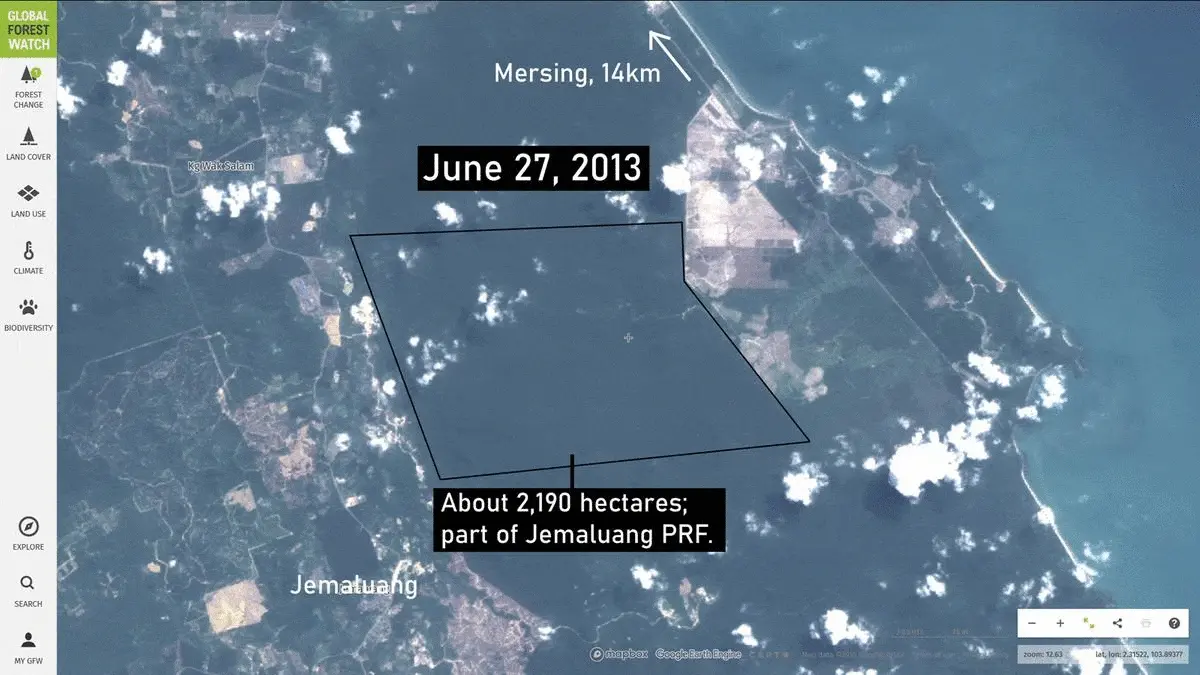
These cleared forests might have harboured large animals like elephants, tigers and tapirs, according to both sites’ EIA documents.
As a result of the excision and clear-cutting, residents in the nearby town of Jemaluang are now at their wits-end, with herds of up to 30 elephants roaming into town and damaging farms and plantations.
Some residents are asking for the cleared forests to be replanted.
Federal master plan
Aside from impacting local wildlife and communities, the excision and subsequent clearing of the Jemaluang PRF has also contradicted the federal government’s master plan for forest connectivity.
The National Physical Plan is the federal government’s highest-level directive for land use planning in the country.
In 2010, the National Physical Plan 2 introduced the Central Forest Spine, a strategy to conserve biodiversity and limit unsustainable development by connecting the largest remaining tracts of forests in Peninsular Malaysia (Map 1).
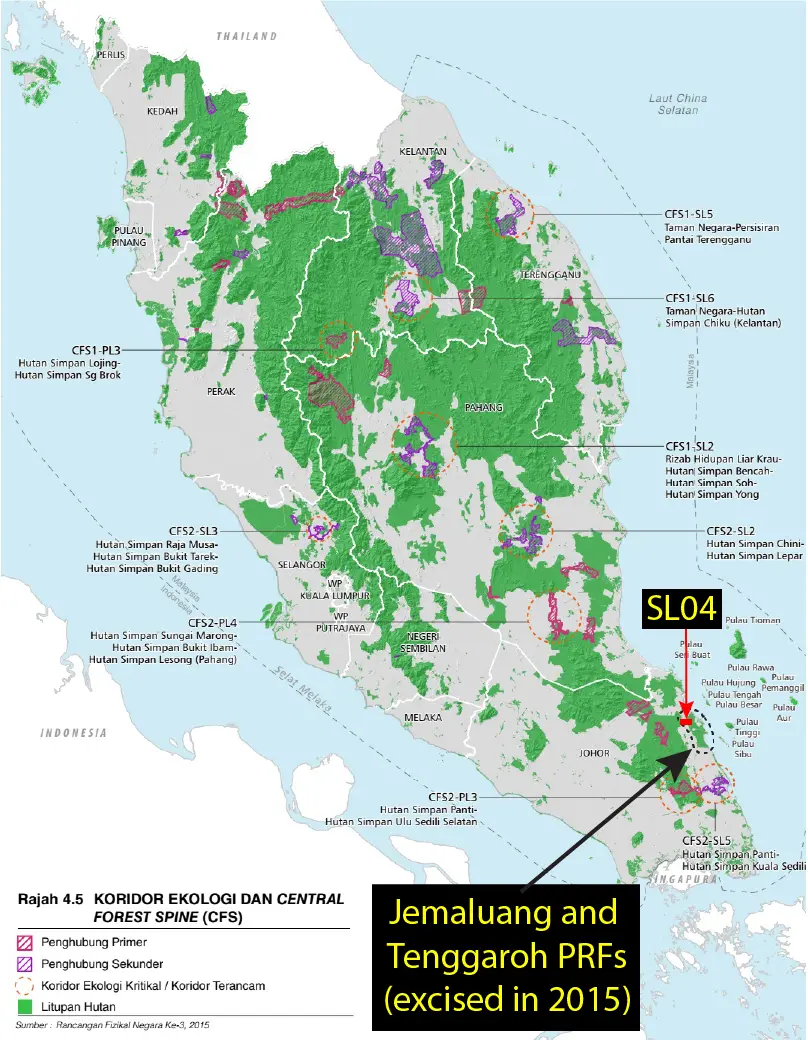
The former Jemaluang PRF was part of the Central Forest Spine master plan.
This master plan had identified an ecological corridor called ‘SL04’ which aimed to connect the forest complexes of Endau-Rompin and Jemaluang, the Ministry of Energy and Natural Resources told Macaranga in a written reply.
The Ministry, which oversees forestry, also said that the federal government through the Ministry continues to “engage closely with the state governments through various platforms in the management and conservation of our forest.”
Ramifications
But now, the Jemaluang PRF has been excised and almost half of it cleared and planted with oil palm.
What ramifications does this have on the Central Forest Spine, SL04 and the National Physical Plan?
Neither the Ministry nor Forestry Department Peninsular Malaysia answered that question.
In the same basket
Other states have lost forest certifications too.
Kelantan lost its certification in 2016 due to the conversion of natural forests to forest plantations in ways that violated the certification.
Kedah lost its certification in 2019, though the exact reason is not known because the public summary report of Kedah’s audit is not available yet.
Johor however, applied anew for the certification and was awarded it in July 2020.
But this time, the certification only covered 285,293 hectares of PRFs in the state, a significant drop from the 321,841 hectares prior to 2015.
Economic consequences
It is not only forestry officers who are concerned about the loss of certification. The loss of certification hurts loggers too.
Amin Mokhtar, the Chairman of the Kedah Timber Association, told Macaranga that logs without certificates are sold at US$150 (RM420) less per tonne.
Siti, senior manager of forest management at the Malaysian Timber Certification Council, said after the three states lost their certificates, she has heard timber companies “complaining that costs have increased because they now have to source [logs] from other states with certification”.
Certification matters
She added that logging associations are “really pleading for us to help them to get their forests re-certified because they aren’t able to sell their [uncertified] timber.”
This was confirmed by Goh Chee Yew, Chairman of Malaysia Wood Industries Association, and the Malaysian Timber Association.
But “we are so powerless” in effecting change in forest management at the state level, said Goh, a 40-year timber industry veteran.
“In terms of regulation, we keep asking questions during dialogues with the forestry departments and state governments.”
“But because forest matters are all under the state government … it’s so complicated…[and] sensitive.”
Edited by SL Wong.
Next in Part 3: What drives the decision-making in land-use change?
This is the second of a four-part In-Depth Macaranga Forest Files feature on forest loss in Peninsular Malaysia. Read also Part 1: Forest loss—under whose watch?
Macaranga's In-Depth series was supported by a grant from the Pulitzer Center’s Southeast Asia Rainforest Journalism Fund awarded to YH Law and SL Wong.
We thank the many foresters, researchers, timber trade stakeholders, lawmakers and citizens living near forests who helped us with our reporting. We also thank the six reviewers of an early draft of this series: Ahimsa Campos-Arceiz, Chua Ern Teck, Nuradilla Mohamad Fauzi, Sharaad Kuttan, Theiva Lingam, and one who wishes to stay anonymous.



